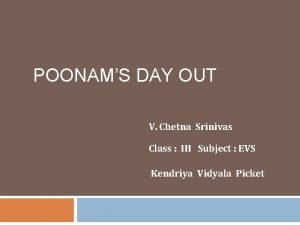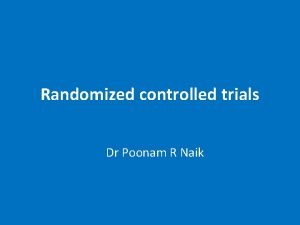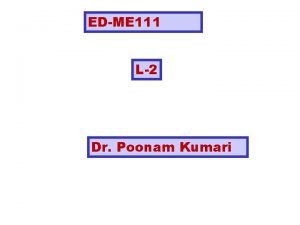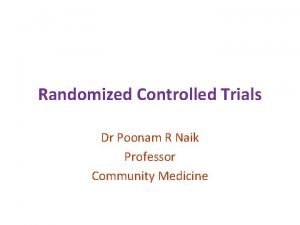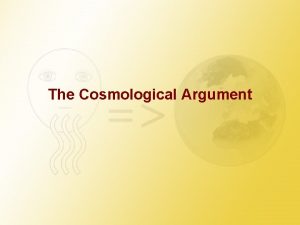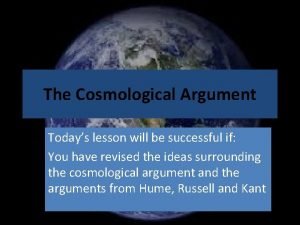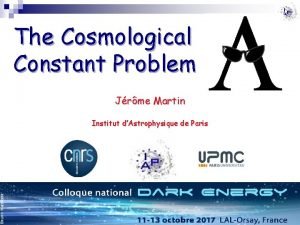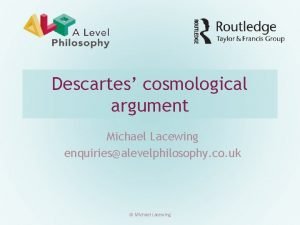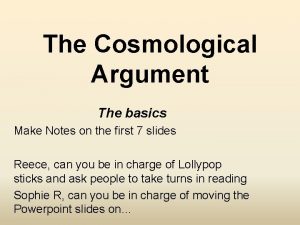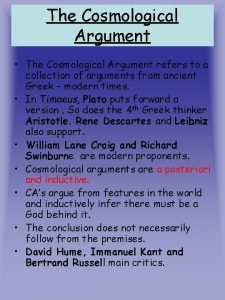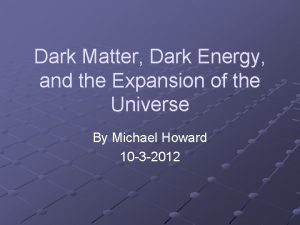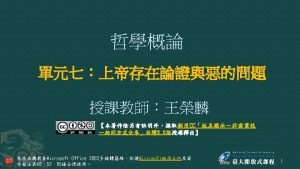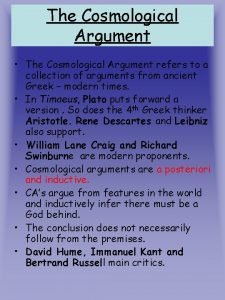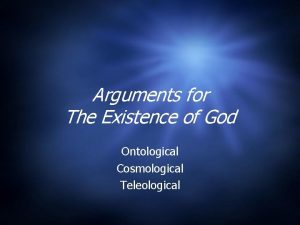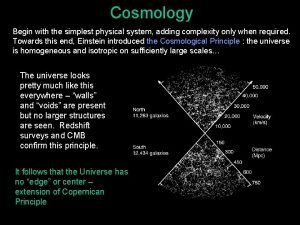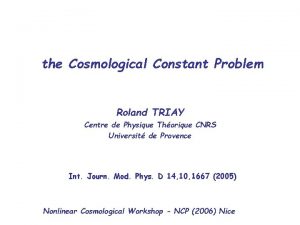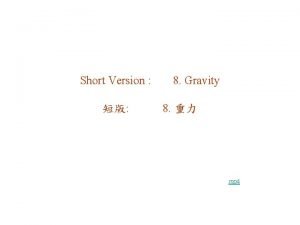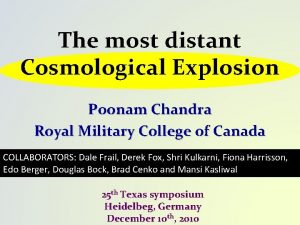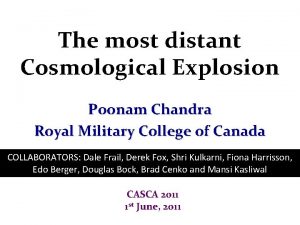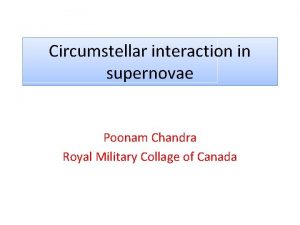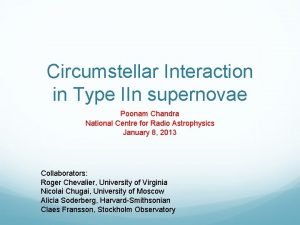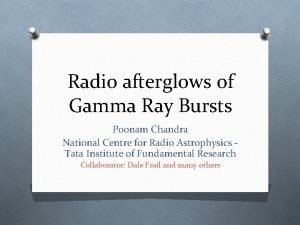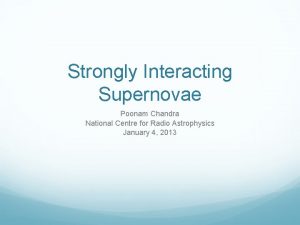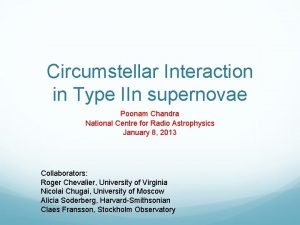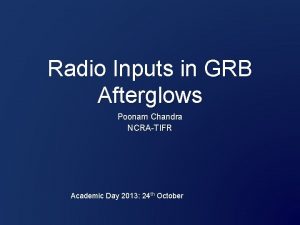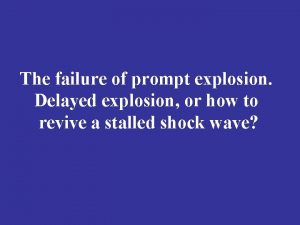The most distant Cosmological Explosion Poonam Chandra Royal





















- Slides: 21

The most distant Cosmological Explosion Poonam Chandra Royal Military College of Canada COLLABORATORS: Dale Frail, Derek Fox, Shri Kulkarni, Fiona Harrisson, Edo Berger, Douglas Bock, Brad Cenko and Mansi Kasliwal CASCA 2011 1 st June, 2011

Gamma Ray Bursts • Detectable at high redshift because of their extreme luminosities. Ionized f(HI) ~ 0 Neutral f(HI) ~ 1 Reionized f(HI) ~ 1 e-5

Gamma Ray Bursts • Excellent probe of IGM and ISM at high-z

Gamma Ray Bursts • Indicative of massive star formation

First stars in the high-z universe Barkana and Loeb (2007) • Initially formed from dark matter mini-halos at z=20 -30 before galaxies • Pop III: M~100 Msun L~105 Lsun T~105 K, Lifetime~2 -3 Myrs • Dominant mode of star formation below 10 -3. 5 Zsolar • Can be found only via stellar deaths

GRB 090423: z=8. 26 Tanvir et al. 2009 Radio Observations of GRB 090423 – CARMA observations, 95 GHz on day 1, 450+/-180 u. Jy – VLA observations starting day 1 until day 65 – First VLA detection on day 7. – Pd. BI, day 1 in 90 GHz. Detection 200 u. Jy.

Detectable in radio due to negative-k correction

Multiwaveband modeling • Long lived afterglow with powerlaw decays • Spectrum broadly consistent with the synchrotron. • Measure Fm, na, nc and obtain Ek (Kinetic energy), n (density), ee, eb (micro parameters), theta (jet break), p (electron spectral index).

Multiwaveband modeling of GRB 090423 (Chandra et al. 2010) Last Chandra measurement

Semianalytic constraints: GEOMETRY OF THE OUTFLOW

Semianalytic constraints: IMMEDIATE ENVIRONS

Semianalytic constraints: ELECTRON ENERGY INDEX

Multiwaveband modeling Yost et al. 2004 using

Discussion on Progenitor star • Signatures of Population III star: Low metalicity and the absence of dust extinction NIR spectroscopy Time is the enemy Spectra taken 1 -3. 5 days later. AG has faded +5 mag Need satellite with NIR imaging and spectroscopy capabilities

Discussion on Progenitor star of GRB 090423 (z=8. 26) Signatures of Pop III progenitor: • Hyper-energetic explosion • Low density HII region – Strong radiation pressure from Pop III star – creates low density (1 cm-3) constant density region (10 pc) • Low metallicity • No published predictions on other afterglow parameters.

Comparison of afterglow properties

Discussion on Progenitor star of GRB 090423 (z=8. 26) • Afterglow properties not sufficient enough to suggest different kind of Progenitor for GRB 090423. • More high-z GRBs required to make a more coherent picture.

Observational Challenge • High z GRBs are rare – Theory. <10% Swift GRBs at z>5 (Loeb & Bromm 2006) – Only 3 GRBs with redshift > 6 • GRB 090423 (z=8. 2) • GRB 080913 (z=6. 7) • GRB 050904 (z=6. 3) • NOW GRB 090429 B (z=9. 4 photometric) astroph-1105. 4915 18

A seismic shift in radio afterglow studies with EVLA • With EVLA and 20 -fold increase in sensitivity, better constraints on geometry, energy and density. No assumptions of geometry required at high redshifts. z=8. 5, EVLA 3σ, Δt=1 hr z=2. 5, EVLA 3σ, Δt=1 hr

ALMA Multiwaveband modeling • Long lived afterglow with powerlaw decays • Spectrum broadly consistent with the synchrotron. • Measure Fm, na, nc and obtain Ek (Kinetic energy), n (density), ee, eb (micro parameters), theta (jet break), p (electron spectral index).

CONCLUSIONS • Radio emission discovered from the highest known redshift object in the Universe. • Star formation taking place at 630 million years age. • The best-fit broad-band afterglow model is a quasispherical (θj>12 o), hyper-energetic (1052 erg) explosion in a constant, low density (n=1 cm-3) medium. • The high energy and afterglow properties of GRB 090423 are not sufficiently different from GRBs at moderate redshift to suggest a different type of progenitor model (e. g. Pop III). • EVLA and ALMA will be important tools for both detecting and studying the first generations of stars in the early universe.
 Can crawl animals
Can crawl animals Types of randomization
Types of randomization Advantages and disadvantages of plugging braking
Advantages and disadvantages of plugging braking Dr poonam sinha
Dr poonam sinha Dr poonam kumari
Dr poonam kumari Dr poonam agarwal
Dr poonam agarwal Poonam naik
Poonam naik St thomas aquinas cosmological argument
St thomas aquinas cosmological argument Kant's criticism of cosmological argument
Kant's criticism of cosmological argument Cosmological constant
Cosmological constant Descartes cosmological argument
Descartes cosmological argument Contigency argument
Contigency argument St thomas aquinas cosmological argument
St thomas aquinas cosmological argument Einstein cosmological constant
Einstein cosmological constant Kalam cosmological argument
Kalam cosmological argument St thomas aquinas cosmological argument
St thomas aquinas cosmological argument Ontological cosmological teleological
Ontological cosmological teleological Lookback time
Lookback time Cosmological constant
Cosmological constant Distant retrograde orbit
Distant retrograde orbit Instructional aims
Instructional aims His wings are clipped and his feet are tied
His wings are clipped and his feet are tied
